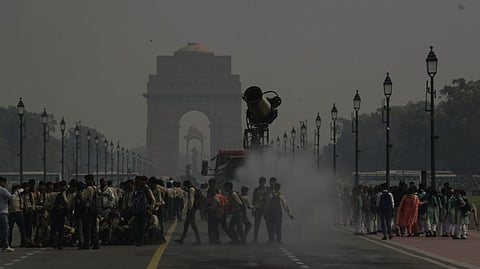

New Delhi | The BJP and AAP traded barbs over pollution levels in Delhi on Sunday as the national capital's air quality once again slipped into the 'very poor' category.
Leader of Opposition in the Delhi Assembly Vijender Gupta hit out at the AAP government, alleging that it had "utterly failed" to control the city's rising pollution.
The people of Delhi are forced to breathe suffocating air while AAP is preoccupied with "hollow promises and low-level politics", Gupta charged.
In response, AAP said in a statement that if Gupta and his party truly cared for Delhi, they should stop their "theatrics" and work with state governments run by the BJP to address the pollution problem in the national capital.
After a two-day gap, Delhi's air quality turned 'very poor' as calm winds prevented the dispersion of pollutants. Some areas in the national capital recorded 'severe' pollution levels.
At 4 pm, Delhi's 24-hour average Air Quality Index (AQI) was recorded at 355 against 255 on Saturday, Central Pollution Control Board (CPCB) data showed.
The CPCB shared data from 37 of the city's 40 monitoring stations. It showed that three stations -- Bawana, Burari and Jahangirpuri -- recorded 'severe' air quality.
The air quality was also 'very poor' in neighbouring areas such as Greater Noida, Ghaziabad and Noida and 'poor' in Faridabad and Gurugram.
Gupta claimed the pollution situation had become so critical that the AQI near ITO and Anand Vihar were recorded at 361 and 405, respectively falling under the 'very poor' and 'severe' categories.
"This poses a serious health threat to Delhi residents (who are) blanketed by smog. Yet, the AAP government lacks both the will and a concrete plan to improve the situation," he charged.
Pollution has reached such a severe level that schoolchildren are beginning to fall ill, leading to a significant drop in attendances. Those who still attend school are compelled to wear masks, Gupta added.
Despite such an "alarming situation", the government remains "inactive", considering its duty fulfilled by merely implementing formalities such as measures under Stage II of GRAP, he said.
"Neither is the government controlling smoke from stubble burning nor is it reducing dust on the roads. Due to the absence of a standing committee in the Municipal Corporation of Delhi, the civic body is also failing to combat pollution," the BJP leader further charged.
Under the Graded Response Action Plan (GRAP), a set of emergency measures to control air pollution in the Delhi-NCR region during winter, air quality is categorised into four stages: Stage I -- 'poor' (AQI 201-300); Stage II -- 'very poor' (AQI 301-400); Stage III -- 'severe' (AQI 401-450); and Stage IV -- 'severe plus' (AQI above 450).
Meanwhile, AAP said it was "well established" that the situation at Anand Vihar was worsening because of pollution caused by diesel buses at the Kaushambi depot in Uttar Pradesh.
Cases of stubble burning are rising each day in BJP-ruled Uttar Pradesh and Haryana, it alleged.
AAP also responded to Gupta's allegations that former chief minister Arvind Kejriwal "misused" crores of rupees from the Delhi government's treasury by repeatedly making false promises to clean the Yamuna.
The river remains as polluted as ever, Gupta said.
AAP hit back at the charge, saying Yamuna pollution was rising because of the high volume of industrial wastewater being released into the river by BJP-ruled Uttar Pradesh and Haryana.
